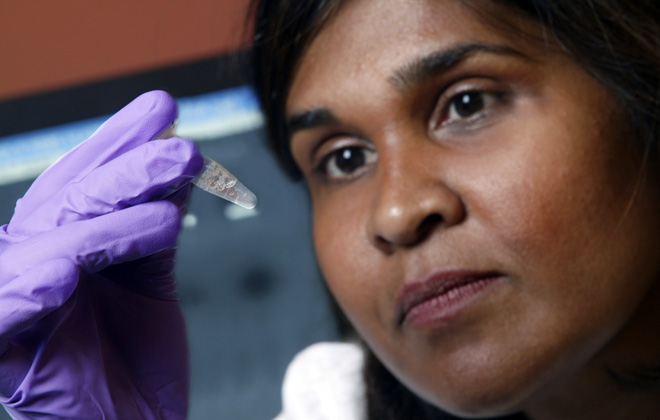Girl, 4, ‘cured’ of HIV sees infection return

Dr. Deborah Persaud, a pediatric HIV expert at Johns Hopkins' Children's Center in Baltimore, held a vial. Doctors and officials at the National Institutes of Health on Thursday said new tests last week showed that a Mississippi girl born with the AIDS virus is no longer in remission. (AP Photo/Johns Hopkins Medicine, File)
A Mississippi girl born with the AIDS virus and in remission for more than two years despite stopping treatment now shows signs that she still harbors HIV — and therefore is not cured. The news is a setback to hopes that very early treatment with powerful HIV drugs might reverse an infection that has seemed permanent once it takes hold.
The girl is now nearly 4. As recently as March, doctors had said that she seemed free of HIV though she was not being treated with AIDS drugs. That was a medical first.
But on Thursday, doctors said they were surprised last week to find the virus in her blood, and there were signs that it was harming her immune system. She is now back on treatment and is responding well, they said.
The news is "obviously disappointing" and will affect a federal study that had been about to start testing early, aggressive treatment in such cases, said Dr. Anthony Fauci, director of the National Institute of Allergy and Infectious Diseases. Doctors had been considering stopping treatment if no signs of infection could be detected after two years.
"We’re going to take a good hard look at the study and see if it needs any modifications," either in terms of length of treatment or because of ethical concerns over raising false hopes about an approach that now has suffered a setback, Fauci said. At a minimum, consent forms to join the study must be revised, he said.
Most HIV-infected moms in the U.S. get AIDS medicines during pregnancy, which greatly cuts the chances they will pass the virus to their babies. The Mississippi baby’s mom received no prenatal care and her HIV was discovered during labor. Because of the baby’s great risk of infection, doctors started her on unusually powerful treatment 30 hours after birth, even before tests could determine whether she was indeed infected.
Don't miss out on what's happening!
Stay in touch with breaking news, as it happens, conveniently in your email inbox. It's FREE!
The girl was treated until she was 18 months old, when doctors lost contact with her. Ten months later when she returned, they could find no sign of infection even though the mom had stopped giving her AIDS medicines.
Tests repeatedly showed no detectable HIV until last week, when copies of the virus were measured in her blood. Doctors say they don’t know why the virus rebounded when it did, and said it raises profound questions about what they know about HIV’s hideouts in the body.
"We are still very much in the early discovery phase of trying to achieve a sustained virological remission and perhaps even a cure. There is much, much more to learn and we remain committed to doing so," Fauci said.
The girl’s experience still suggests that early, aggressive treatment can limit the size of the reservoir of dormant virus in the body and help control infection, said one specialist involved in the case, Dr. Deborah Persaud of Johns Hopkins Children’s Center in Baltimore.
"What we’ve learned from this case is really quite amazing," said Jeffrey Safrit, research chief at the Elizabeth Glaser Pediatric AIDS Foundation. "They were able to suppress virus for a very long time without therapy. We need to take the positive aspects of this case and learn from them to move forward" with the federal study, he said.
In March, doctors revealed that a second baby born with HIV may have had her infection put into remission by very early treatment — in this case, four hours after her birth in suburban Los Angeles in April 2013. Nearly a year later, very sophisticated tests at multiple times suggested she had completely cleared the virus, but she remains on treatment so there is no way to know for sure.
Only one other person is thought to have been cured of HIV infection — a San Francisco man who had a bone marrow transplant in 2007 from a donor with natural resistance to HIV. He showed no sign of infection more than five years later.
Online:
AIDS information: http://www.aidsinfo.nih.gov Opens in a new tab
and http://www3.niaid.nih.gov/topics/HIVAIDS/ Opens in a new tab



